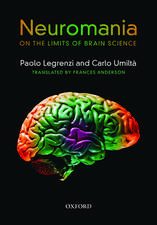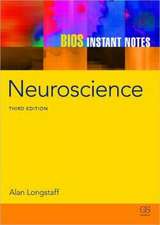Creating Brain-Like Intelligence: From Basic Principles to Complex Intelligent Systems: Lecture Notes in Computer Science, cartea 5436
Editat de Bernhard Sendhoff, Edgar Körner, Olaf Sporns, Helge Ritter, Kenji Doyaen Limba Engleză Paperback – 2 apr 2009
Din seria Lecture Notes in Computer Science
- 20%
 Preț: 1061.55 lei
Preț: 1061.55 lei - 20%
 Preț: 307.71 lei
Preț: 307.71 lei - 20%
 Preț: 438.69 lei
Preț: 438.69 lei - 20%
 Preț: 579.30 lei
Preț: 579.30 lei -
 Preț: 410.88 lei
Preț: 410.88 lei - 17%
 Preț: 427.22 lei
Preț: 427.22 lei - 20%
 Preț: 596.46 lei
Preț: 596.46 lei - 15%
 Preț: 448.04 lei
Preț: 448.04 lei - 20%
 Preț: 353.50 lei
Preț: 353.50 lei -
 Preț: 389.49 lei
Preț: 389.49 lei - 20%
 Preț: 309.90 lei
Preț: 309.90 lei - 20%
 Preț: 645.28 lei
Preț: 645.28 lei - 20%
 Preț: 763.23 lei
Preț: 763.23 lei - 15%
 Preț: 580.46 lei
Preț: 580.46 lei - 20%
 Preț: 310.28 lei
Preț: 310.28 lei - 20%
 Preț: 655.02 lei
Preț: 655.02 lei - 20%
 Preț: 1183.14 lei
Preț: 1183.14 lei - 20%
 Preț: 340.32 lei
Preț: 340.32 lei -
 Preț: 449.57 lei
Preț: 449.57 lei - 20%
 Preț: 591.51 lei
Preț: 591.51 lei - 18%
 Preț: 938.83 lei
Preț: 938.83 lei - 20%
 Preț: 337.00 lei
Preț: 337.00 lei - 20%
 Preț: 649.50 lei
Preț: 649.50 lei - 20%
 Preț: 607.40 lei
Preț: 607.40 lei - 20%
 Preț: 1414.79 lei
Preț: 1414.79 lei - 20%
 Preț: 1024.44 lei
Preț: 1024.44 lei - 20%
 Preț: 583.40 lei
Preț: 583.40 lei - 20%
 Preț: 453.32 lei
Preț: 453.32 lei - 20%
 Preț: 575.49 lei
Preț: 575.49 lei - 20%
 Preț: 1075.26 lei
Preț: 1075.26 lei - 20%
 Preț: 585.88 lei
Preț: 585.88 lei - 20%
 Preț: 825.93 lei
Preț: 825.93 lei - 17%
 Preț: 360.20 lei
Preț: 360.20 lei - 20%
 Preț: 763.23 lei
Preț: 763.23 lei - 20%
 Preț: 340.32 lei
Preț: 340.32 lei - 20%
 Preț: 504.58 lei
Preț: 504.58 lei - 20%
 Preț: 369.13 lei
Preț: 369.13 lei - 20%
 Preț: 580.93 lei
Preț: 580.93 lei - 20%
 Preț: 343.62 lei
Preț: 343.62 lei - 20%
 Preț: 350.21 lei
Preț: 350.21 lei - 20%
 Preț: 583.40 lei
Preț: 583.40 lei - 20%
 Preț: 583.40 lei
Preț: 583.40 lei - 15%
 Preț: 438.59 lei
Preț: 438.59 lei - 20%
 Preț: 341.95 lei
Preț: 341.95 lei - 20%
 Preț: 238.01 lei
Preț: 238.01 lei - 20%
 Preț: 538.30 lei
Preț: 538.30 lei
Preț: 644.82 lei
Preț vechi: 758.60 lei
-15% Nou
Puncte Express: 967
Preț estimativ în valută:
123.40€ • 133.100$ • 103.66£
123.40€ • 133.100$ • 103.66£
Carte tipărită la comandă
Livrare economică 22 aprilie-06 mai
Preluare comenzi: 021 569.72.76
Specificații
ISBN-13: 9783642006159
ISBN-10: 3642006159
Pagini: 369
Ilustrații: VIII, 351 p.
Dimensiuni: 155 x 235 x 23 mm
Greutate: 0.54 kg
Ediția:2009
Editura: Springer Berlin, Heidelberg
Colecția Springer
Seriile Lecture Notes in Computer Science, Lecture Notes in Artificial Intelligence
Locul publicării:Berlin, Heidelberg, Germany
ISBN-10: 3642006159
Pagini: 369
Ilustrații: VIII, 351 p.
Dimensiuni: 155 x 235 x 23 mm
Greutate: 0.54 kg
Ediția:2009
Editura: Springer Berlin, Heidelberg
Colecția Springer
Seriile Lecture Notes in Computer Science, Lecture Notes in Artificial Intelligence
Locul publicării:Berlin, Heidelberg, Germany
Public țintă
ResearchCuprins
Creating Brain-Like Intelligence.- From Complex Networks to Intelligent Systems.- Stochastic Dynamics in the Brain and Probabilistic Decision-Making.- Formal Tools for the Analysis of Brain-Like Structures and Dynamics.- Morphological Computation – Connecting Brain, Body, and Environment.- Trying to Grasp a Sketch of a Brain for Grasping.- Learning Actions through Imitation and Exploration: Towards Humanoid Robots That Learn from Humans.- Towards Learning by Interacting.- Planning and Moving in Dynamic Environments.- Towards Cognitive Robotics.- Approaches and Challenges for Cognitive Vision Systems.- Some Requirements for Human-Like Robots: Why the Recent Over-Emphasis on Embodiment Has Held Up Progress.- Co-evolution of Rewards and Meta-parameters in Embodied Evolution.- Active Vision for Goal-Oriented Humanoid Robot Walking.- Cognitive Adequacy in Brain-Like Intelligence.- Basal Ganglia Models for Autonomous Behavior Learning.
Textul de pe ultima copertă
This state-of-the-art-survey documents the scientific outcome of the International Symposium „Creating Brain-Like Intelligence", which took place in Hohenstein, Germany, in February 2007. It presents an introduction to this emerging interdisciplinary field by drawing together 15 articles from researchers across a broad range of disciplines.
Brain-Like intelligence attempts a representation of the environment including the system itself. It has to cope with a continuous influx of an immense amount of mostly unspecific information and cannot be identified with a singular functionality. It is the versatility of brain-like intelligence, its robustness and plasticity which makes it the object of our quest.
After 50 years of artificial intelligence research however, we are still not able to mimic even the lower level sensory capabilities of animals. But we are beginning to move in the right direction by identifying the biggest obstacles and starting to understand the autonomy, flexibility, and robustness of intelligent biological systems. This collection of articles is evidence of this progress and represents the current state of art in several research fields that are embraced by brain-like intelligence.
Brain-Like intelligence attempts a representation of the environment including the system itself. It has to cope with a continuous influx of an immense amount of mostly unspecific information and cannot be identified with a singular functionality. It is the versatility of brain-like intelligence, its robustness and plasticity which makes it the object of our quest.
After 50 years of artificial intelligence research however, we are still not able to mimic even the lower level sensory capabilities of animals. But we are beginning to move in the right direction by identifying the biggest obstacles and starting to understand the autonomy, flexibility, and robustness of intelligent biological systems. This collection of articles is evidence of this progress and represents the current state of art in several research fields that are embraced by brain-like intelligence.















